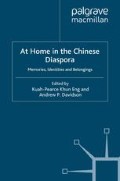Abstract
Diasporic communities and their concomitant trajectories provide critical spaces to examine and come to terms with the dramatic migrations that have defined recent human history and appear to continue unabated in this century. Like Alice in Through the Looking-Glass, movement is about constructing narratives of self and ‘home’. In Kondo’s (1996, p. 97) words, home ‘stands for a safe place, where there is no need to explain oneself to outsiders; it stands for community’. In this respect, memories as narrative and ‘things’ establish a bridge between the old and new life worlds, as well as provide a bond between the past, present and future. But migration is seldom a simple matter of undisturbed movement as Alice discovered when admonished by the Queen, ‘It’s a poor sort of memory that only works backwards’, a point made in Memories of a Future Home: Diasporic Citizenship of Chinese in Panama, where Lok Siu explores how diasporic Chinese in Panama constructed a home and created a sense of belonging while inhabiting the interstices of multiple cultures.
In another moment Alice was through the glass, and had jumped lightly down into the Looking-glass room. The very first thing she did was to look whether there was a fire in the fireplace, and she was quite pleased to find that there was a real one, blazing away as brightly as the one she had left behind. So I shall be as warm here as I was in the old room, thought Alice: warmer, in fact, because there’ll be no one here to scold me away from the fire. Oh, what fun it’ll be, when they see me through the glass in here, and can’t get at me!
Lewis Carroll, Through the Looking-Glass (1991)
Access this chapter
Tax calculation will be finalised at checkout
Purchases are for personal use only
Preview
Unable to display preview. Download preview PDF.
References
Anthias, F. 2001a, ‘The Material and the Symbolic in Theorizing Social Stratification: Issues of Gender, Ethnicity and Class’, British Journal of Sociology, vol. 52, no. 3, pp. 367–90.
Anthias, F. 2001b, ‘New Hybridities, Old Concepts: the Limits of “Culture”’, Ethnic and Racial Studies, vol. 24, no. 4, pp. 619–41.
Appadurai, A. 1996, Modernity at Large: Cultural Dimensions of Globalization, University of Minnesota Press, Minneapolis.
Balibar, E. 1991, ‘Is there a “New-Racism”?’ in E. Balibar and I. Wallerstein (eds), Race, Nation, Class: Ambiguous Identities, Verso Press, London, pp. 17–28.
Begum, A. 1999, Destination Dhaka: Urban Migration: Expectations and Reality, University Press Ltd, Dhaka.
Bender, B. 1993, Landscapes: Politics and Perspectives, Routledge, London.
Berliner, R. 2005, ‘The Abuses of Memory: Reflections of the Memory Boom in Anthropology’, Anthropological Quarterly, vol. 78, no. 1, pp. 197–211.
Carroll, L. 1991, Through the Looking Glass, Project Gutenberg and Duncan Research Shareware, viewed 20 January 2007 <http://www.cs.indiana.edu/metastuff/looking/Iooking.txt.gz>.
Castles, S. 2002, ‘Migration and Community Formation under Conditions of Globalization’, International Migration Review, vol. 36, no. 4, pp. 1143–68.
Chow, R. 1991, Woman and Chinese Modernity: the Politics of Reading between West and East, University of Minnesota Press, Minneapolis.
Cixous, H. 1982, ‘Introduction to Lewis Carroll’s: Through the Looking-Glass and The Hunting of the Snark’, New Literary History, vol. 13, no. 2, pp. 231–51.
Ganguly, K. 1992, ‘Migrant Identities: Personal Memory and the Construction of Selfhood’, Cultural Studies, vol. 6, no. 1, pp. 27–50.
Gilroy, P. 1993, The Black Atlantic: Modernity and Double Consciousness, Harvard University Press, Cambridge, London.
Glenn, E. 1999, ‘The Social Construction and Institutionalization of Gender and Race: an Integrative Framework’, in M. Ferree, J. Lorber and B. Hess (eds), Revisioning Gender, Sage Publications, Thousand Oaks, California, pp. 3–43.
Hames-García, M.R. 2000, ‘“Who are our own People?”: Challenges for a Theory of Social Identity’, in P. Moya and M. Hames-García (eds), Realist Theory and the Predicament of Postmodernism, University of California Press, Berkeley, pp. 102–9.
Kandiyoti, D. 1988, ‘Bargaining and Patriarchy’, Gender and Society, vol. 2, no. 3, pp. 274–90.
Kondo, D. 1996, ‘The Narrative Production of “Home”, Community, and Political Identity in Asian American Theater’, in S. Lavie and T. Swedenburg (eds), Displacement, Diaspora, and the Geographies of Identity, Duke UP, Durham, pp. 97–118.
Osborne, B. 2006, ‘From Native Pines to Diasporic Geese: Placing Culture, Setting our Sites, Locating Identity in a Transnational Canada’, Canadian Journal of Communication, vol. 31, no. 1, pp. 147–75.
Park, R.E. 1928, ‘Human Migration and the Marginal Man’, American Journal of Sociology, vol. 33, no. 6, pp. 881–93.
Seyhan, A. 2000, Writing outside the Nation, Princeton University, Princeton.
Sun, W. 2002, Leaving China: Media, Migration and Transnational Imagination, Rowman and Littlefield Publishers, Lanham, Maryland.
Watkins, R., Plant, A.J., Sang, D., O’Rourke, T., Le, V., Nguyen, H. and Gushulak, B. 2003, ‘Research Note. Individual Characteristics and Expectations about Opportunities in Australia among Prospective Vietnamese Migrants’, Journal of Ethnic and Migration Studies, vol. 29, no. 1, pp. 157–66.
Westwood, S. and Phizacklea, A. 2000, Trans-Nationalism and the Politics of Belonging, Routledge, London.
Yick, A. 2001, ‘Feminist Theory and Status Inconsistency Theory: Application to Domestic Violence in Chinese Immigrant Families’, Violence against Women, vol. 7, no. 5, pp. 545–62.
Zhou, Y. 2000, ‘The Fall of “the Other Half of the Sky”? Chinese Immigrant Women in the New York Area’, Women’s Studies International Forum, vol. 23, no. 4, pp. 445–59.
Editor information
Editors and Affiliations
Copyright information
© 2008 Andrew P. Davidson
About this chapter
Cite this chapter
Davidson, A.P. (2008). Conclusion: through the Diasporic Looking-Glass. In: Eng, KP.K., Davidson, A.P. (eds) At Home in the Chinese Diaspora. Palgrave Macmillan, London. https://doi.org/10.1057/9780230591622_14
Download citation
DOI: https://doi.org/10.1057/9780230591622_14
Publisher Name: Palgrave Macmillan, London
Print ISBN: 978-1-349-35330-9
Online ISBN: 978-0-230-59162-2
eBook Packages: Palgrave Social & Cultural Studies CollectionSocial Sciences (R0)

